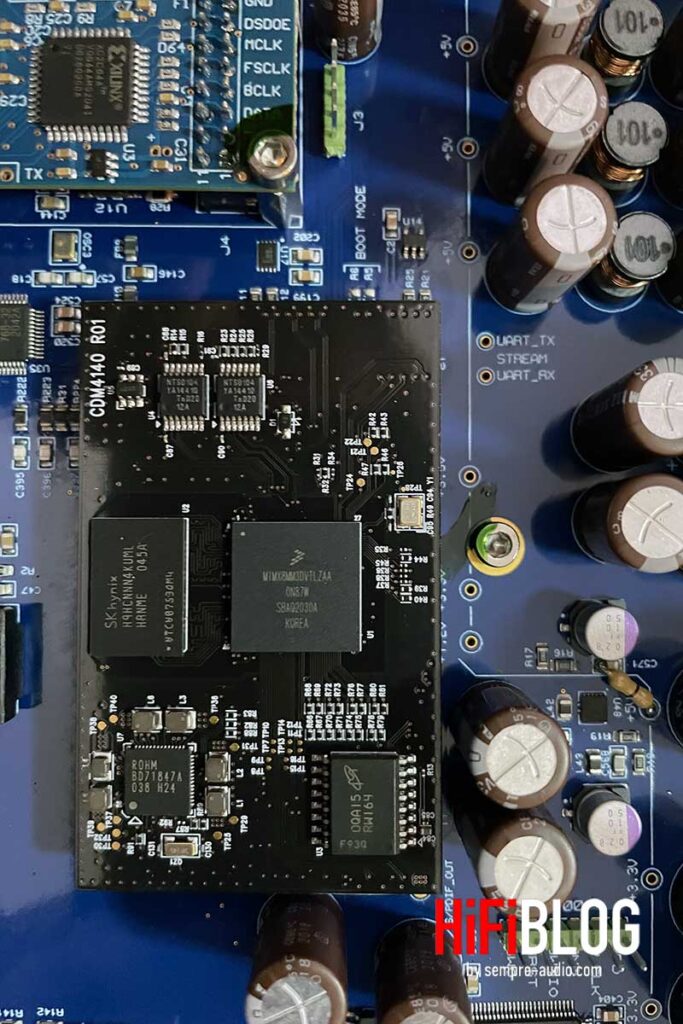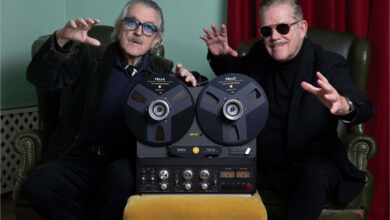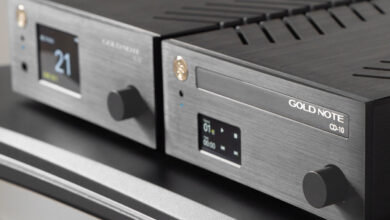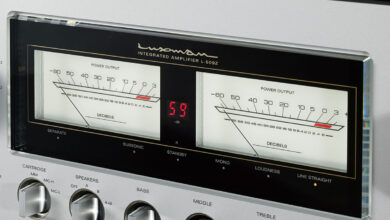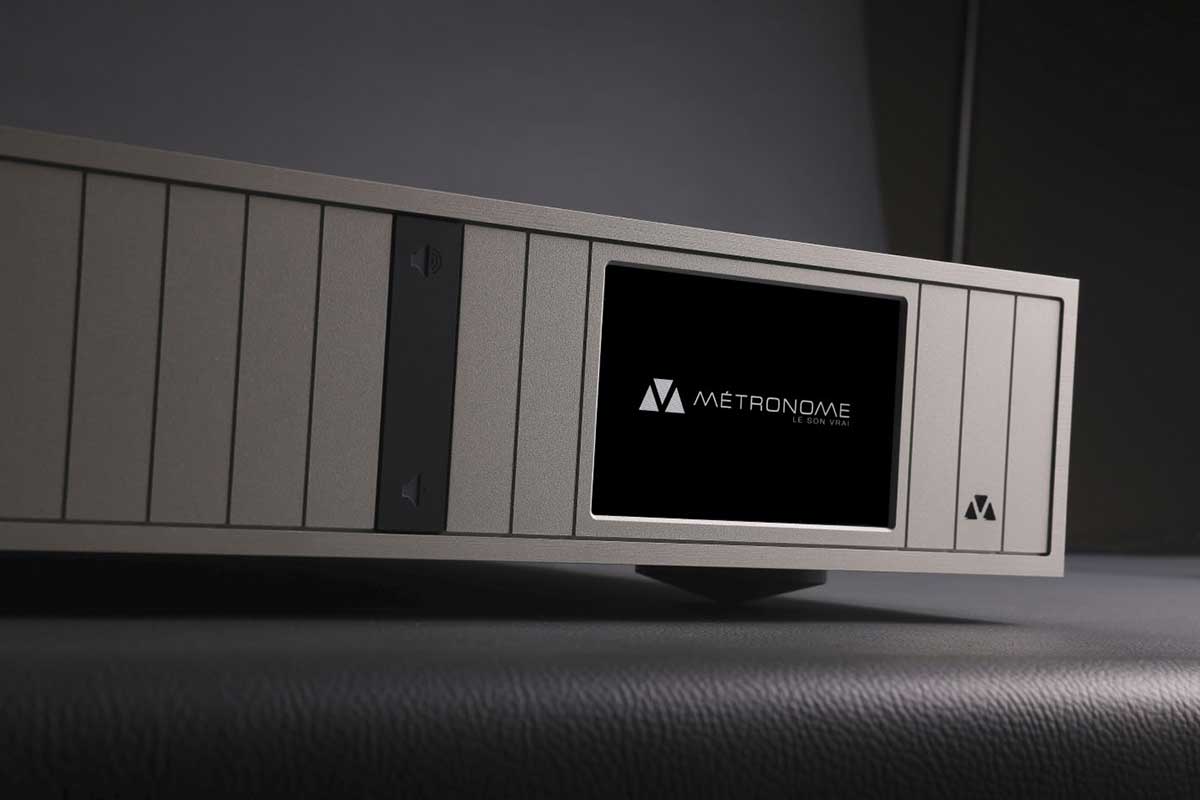
There are many streaming systems on the market, and a wide variety of manufacturers offer their solutions in different price ranges. So what can a streaming solution from a proven digital specialist such as Metronome Technologie offer, which, like the Metronome DSC, sees itself as a reference solution, and where one speaks of not having to make any compromises?
Metronome DSC is the name of the solution that the French high-end specialist Metronome Technologie envisages as the central component for music streaming at the very highest level. DSC, this abbreviation stands for Digital Sharing Converter and in principle describes quite well that a holistic approach is pursued here, covering the topic of streaming in the broadest sense so that users actually get a solution from a single source that does not require any compromises in terms of flexibility and quality.
Actually, the Metronome DSC should be called a three-in-one solution, because streaming is its primary task, but it is only one area that this solution ultimately covers. From the point of view of Metronome technology, a D/A converter and a digital preamplifier also belong to the basic equipment of a streaming system and thus to the Metronome DSC. This optimally coordinated combination of three essential functions provides the perfect basis for streaming at the quality level that the French want to guarantee.
Metronome DSC – The high-end plug & play “three-in-one” device
It seems interesting that the French specialist attracts attention with a term that one would hardly expect in this price range, namely with the term Plug & Play, which is often overused in the IT environment.
Plug & Play means nothing more than a particularly simple installation and handling. The user is supposed to get the impression that he’s buying a solution whose functionality he doesn’t have to worry about at all. Why, why, and how something works here is completely irrelevant, it simply works.
And this brings us to a very crucial point, a feature that is clearly the focus of solutions like the Metronome DSC and explains why people talk about Plug & Play.
Specialists like Metronome Technologie try to address a target group with their products that wants to use the advantages that streaming generally brings along, without having to accept the disadvantages that can also come along with it.
As a customer, you leave it completely up to a proven specialist to think about how to best fulfill the task at hand, while you alone benefit from the end result of this sometimes complex development process.
Streaming – A thoroughly complex topic
It has to be said that streaming in general can be quite a complex topic, even though it is often described as simple, even simplistic.
Somewhere data are “stored”, which are fed via the network to the streaming client, which processes them as accurately as possible, provides for a simple, at best intuitive control, and presents them either via an integrated converter or an external converter in best quality. At least that’s the theory.
But streaming means that IT and HiFi have to work together as perfectly as possible, and we know that IT can be quite a complex topic with many pitfalls in practice. At the very least, it’s a topic you have to deal with if you want to make the best use of solutions in this environment.
Let’s just say the truth, a streaming client is and remains nothing more than a “computer”, so at least some expertise is of interest, even if nobody wants or needs to deal with the actual inner workings of such solutions these days.











A streaming client is a computer
This has been true from the very beginning, for example for those solutions that could be used for music playback on the PC for the first time in the 1990s and thus ultimately established the topic of streaming. The resentment of many audiophiles that valuable music could not be left to a disdainful PC probably dates back to this time.
And in fact, it was primarily IT companies that established streaming in the broadest sense, such as Logitech, Creative Labs or Terratec, some may still remember these companies. And as early as the 1990s, there were some providers who were particularly intensively involved with this topic and were intent on offering quality, although these approaches were also found solely in IT.
Streaming in the field of consumer electronics first gained momentum with solutions from Apple Corporation or Sonos Inc.; for hi-fi enthusiasts, it then began to become interesting when two English hi-fi companies – Linn and Naim – presented corresponding solutions.
Nowadays, streaming is the predominant topic in the entire consumer electronics, thus also in the world of HiFi and even the designated high-end HiFi. But still, in essence, every streaming client is a computer…
But why are we so anxious to make this point clear to you, dear reader? Well, it is the pivotal point in understanding what distinguishes solutions such as those from Metronome Technologie, and here quite specifically the Metronome DSC.
Again, at its core, it’s a computer, at least when it comes to that part that’s designed for streaming. And as is true everywhere, not all computers are the same, and it is possible to implement solutions in the IT environment that differ drastically in quality from the rest of what is available on the market.
Is quality a question of performance?
Particularly when it comes to IT, to computers, if you will, performance is of course of immense importance. It is essential that data – and that is what audio signals in digital form are all about – can be processed with the appropriate performance. This is the only way to guarantee accurate playback based on a constant data stream.
However, it should be said at this point that modern computer systems have long since reached a performance class that offers more than sufficient performance. When we talk about streaming, we are not only talking about audio, but also about video, and modern solutions allow streaming in unprecedented quality and resolution. 4K or even 8K are possible without any problems, whereby this not only includes the actual video content, but also hi-res audio, even in surround sound.
Audio streaming in stereo alone, even in Studio Master quality with 24 bit or even 32 bit, even DSD in all its varieties, all this presents solidly equipped modern IT solutions with no real problems when it comes to performance. Compared to video, the amount of data that has to be processed accurately is much smaller.
Much more decisive for the question of quality is therefore how the data is handled, and in particular how the data is kept away from interfering influences. So if you look at a streaming client quite banally as a “computer”, very practical questions arise around the selection of the right components, the optimal design of the circuit, and not least the best possible shielding of particularly sensitive components.
Can music be left to a “PC”?
In view of a tough price war on the market, many companies rely on standard components, so the basis of many streaming clients is often similar, even if they come from different manufacturers.
A look inside many a current solution clearly shows this, as well as the fact that there is often only a tiny circuit board to be found, and the fancy case appears quite empty apart from that. And this is true even if it is not only a pure streaming client, but possibly also a streaming client plus integrated D/A converter.
Highly integrated circuits make this and much more possible, even a preamplifier can be added without any problems, so basically exactly the range of functions Metronome Technologie promises for the Metronome DSC…
But we can promise you one thing, the Metronome DSC has nothing to do with most solutions on the market, it plays in a completely different league, you can even say in a league of its own.
But what is it exactly that makes Metronome Technologie different from many other suppliers and thus helps the Metronome DSC to achieve an outstanding position on the market? This is the question we now want to explore. But first, a little family history.
Metronome Digital Sharing Range
The Metronome DSC is part of a whole family that combines Metronome technology under the term Digital Sharing and thus the Metronome Digital Sharing Range of the same name. In addition to the Metronome DSC, this family also includes the Metronone DSC1 and Metronome DSS systems.
The Metronome DSS Network Player and Streamer is, as the name suggests, designed solely as a streaming client, the Metronome DSC1 Converter and Streamer adds a D/A converter, and the Metronome DSC Digital Converter, Streamer and Pre-amp combines all the functions that Metronome technology can offer in this product line, making it the flagship of the series.
Metronome DSC – Digital Sharing Converter
“Digital Sharing”, this description stands for Metronome technology first and foremost for streaming, therefore we also speak so far first and foremost of a streaming client. Adding two more essential components here – a D/A converter and a digital preamplifier – makes the Metronome DSC a true plug & play system, described as a “three-in-one” device.
Cable or WiFi?
First of all, the Metronome DSC is connected to the network via a cable, for which an Ethernet interface is available. However, a WiFi adapter in the form of a USB dongle that complies with IEEE 802.11ac is also included.
Hand on heart, we would prefer the cable in any case, but this is just a side note.
UPnP as a basis
When it comes to streaming, Jean Marie Clauzel, owner and designer of Metronome technology, trusts UPnP first and foremost, and that is simply a consistent decision.
Although there are numerous streaming platforms and technologies on the market, UPnP remains the only real industry standard. All other platforms and technologies are developments of one manufacturer, even if some of them are used, i.e. licensed, by various other companies.
UPnP and the likewise designated dlna licensing of the Metronome DSC ensure that the highest degree of flexibility is maintained for all components that comprise a streaming system. This starts with the central storage systems, a so-called NAS (Network Attached Storage), via any streaming clients that are additionally used in the house and are controlled centrally, and extends to the apps that are essential for precisely this convenient control.
The user can choose the solution that best suits his needs in all areas and is not limited to this or that manufacturer.
However, this does not mean that popular online offers are left out; this is explicitly stated.
TIDAL, Qobuz, Deezer, Spotify…
The Metronome DSC can of course be used to access the most important services, as long as you have a corresponding subscription. The streaming offer of TIDAL and Qobuz can be used as well as that of Deezer.
This means that more or less all services relevant for demanding HiFi enthusiasts are available for music playback, so you can access millions and millions of music titles in at least “CD quality”, as well as thousands and thousands of albums in Hi-res audio.
It is exciting that Metronome Technologie has also decided to support the Spotify service, even if it does not yet have an offer designed for demanding users.
In this regard, it should be said that Spotify’s offer will also improve in terms of quality in the near future, and it is also the service that has by far the most customers, including many hi-fi enthusiasts, simply because of the largest offer and unique features. So it would not be a smart tactic to simply exclude them.
Roon soon to be another option
Users who rely on the currently most flexible streaming platform Roon from the software company Roon Labs LLC. for streaming will notice in their app that the Metronome DSC already appears there in principle as a streaming device, but is still marked with the note that the certification has not been fully completed.
When this certification process has been fully completed by the manufacturer, the Metronome DSC will be designated as Roon-ready, so that it can be used as a streaming client on RAAT (Roon Audio Advanced Transport) to provide bit-perfect music streaming via the media management and multi-room audio streaming solution from Roon Labs LLC. to offer bit-perfect music streaming.
Internet Radio
Just so we don’t forget, the Metronome DSC also allows Internet Radio, via the vTuner service. This may not seem essential to some, as these are offerings that “play” far, far away from high-end HiFi. For some music enthusiasts, however, the advantage of being able to access a worldwide range of different content in the simplest way outweighs this.
So much for the topic of streaming, let’s now look at the component that on the one hand takes care of the signal processing of the streamed content, but also ensures that the Metronome DSC is open to other source devices in the HiFi network…
Signal processing with 32 bit and 384 kHz, DSD512 and MQA
The heart of the signal processing of the Metronome DSC is a D/A converter of the type ESS ES9038PRO, whereby one relies on a dual-mono structure and which supports signals in Linear PCM with up to 32 bits and 384 kHz and thus in the format designated as DXD, and which is also equipped for contents in DSD. Here, the spectrum even extends to signals with DSD512.
Content encoded in the lossy MQA compression method with DRM (Digital Rights Management) is also processed here, which is especially interesting for users who rely on streaming services with correspondingly encoded content.
Versatile D/A converter
In order to fulfill its task as a D/A converter in the best possible way, the Metronome DSC offers a wealth of interfaces. First and foremost, an optical as well as coaxial S/PDIF interface is available on the back of the system, as well as an AES/EBU and HDMI interface. However, it should be noted that this is not a conventional HDMI interface, but rather a so-called I2S interface, which many experts believe is by far the most reliable way to transmit audio in digital form. By the way, the full resolution is only available via this I2S interface, it also supports Linear PCM as well as DSD, whereas the other interfaces mentioned so far are only limited to Linear PCM with 24 bit and 192 kHz.
Of course, USB ports should not be missing, and there are four of them on the Metronome DSC. Two are designed for the direct connection of corresponding storage media, so that music can be played directly without a network infrastructure.
The third USB port (USB Type B) is used for direct connection to a PC or Mac, so that the Metronome Digital Sharing Converter can be used as an outstanding audio interface. It goes without saying that this interface relies on asynchronous data transfer, where only the Metronome DSC has control over the data and its timing, so that jitter is kept to a minimum. The Metronome DSC can also exploit its full potential via this USB interface and play back content in Linear PCM as well as DSD. This is especially exciting when using solutions such as Audirvana Studio, which should be mentioned in passing.
The last remaining USB interface in our list is marked as “service”, so it doesn’t fulfill any function for the user.
Preamp with unique volume control
In its function as a digital preamp, the Metronome DSC can first and foremost come up with an outstanding feature, namely the so-called Leedh Processing Volume Control. Here Metronome Technology relies on the cooperation or partnership with Leedh Processing and thus guarantees a volume control with no loss of resolution. This only affects the signal amplitude and does not cause any changes to the signal quality.
Unbalanced as well as balanced output stage
On the analog level, audio signals leave the Metronome DSC in either unbalanced or balanced form. For this purpose, not only a pair of RCA jacks is available as analog output, but also a pair of XLR connectors for balanced connection, in this case directly to a pair of active speaker systems or a power amplifier.
Simple operating concept
The front panel of the Metronome DSC features nothing more than a rocker-style volume control, a status LED, and a very generously sized display. And this display serves as the central control element, because it is a touchscreen display.
On the bottom, you can select the active input or the streaming option or playback directly from USB, and you can also control the volume here. In principle, that’s all there is to it. That’s all you need. However, that’s not quite true, because a submenu provides a filter setup to adapt the signal conversion according to your own wishes. It should be said that experimenting is definitely worthwhile here, although you can expect such things in this class. This, as well as the possibility to adjust the output level, is by no means outstanding, but of course worth mentioning as fine features. Likewise, that you can choose the background image of the display from various options.
Of course, the Metronome DSC comes with a matching infrared remote control, which leaves its very high-quality impression when you hold it in your hands, we would also like to explicitly emphasize that.
When it comes to streaming, one might think that an app should not be missing, however, Metronome Technology actually does not offer a separate app. Rather, it is deliberately left up to the user to choose the best app for him; thanks to UPnP, the selection is almost gigantic. However, the manufacturer still recommends one app in particular, the mConnect Control App from Conversdigital Co. Ltd, which is known as a versatile solution. This app is available for Apple iOS as well as Google Android.
The previously mentioned streaming offers are also accessible via this app, which should be explicitly mentioned again here.
Perfection down to the last detail
Looking at the Metronome DSC quite soberly, we have learned so far that it is a streaming client, a D/converter, and a digital preamp. In this respect, the solution proves to be a solidly equipped system, but nothing really stands out in terms of the bare numbers. The listed performance data corresponds to what one can expect from a streaming client nowadays.
So what is it that really sets the Metronome DSC apart from many other solutions on the market?
Well, again we have to refer to our very detailed introduction and state once again that a streaming client is a “computer” and its true quality level is determined first and foremost by how “IT” and “HiFi” are combined, especially when this is done in a single device.
A look under the hood
Nine screws have to be loosened to look at what a proven digital specialist like Metronome Technologie puts in to achieve nothing less than perfection.
What is revealed to the viewer here is simply engineering at the very highest level.
You remember that we said that performance is no longer a real problem? In fact, the actual heart of the Metronome DSC is an ARM Cortex M4 32 bit RISC processor from STMicroelectronics N.V., ultimately a small, separately designed circuit board that seems almost inconspicuous in view of what else fills the inside of the device. While the housings of many similarly designed products are equipped with a manageable number of components in terms of functionality, the Metronome DSC’s elaborately equipped circuit boards take up the entire housing.
First and foremost, three toroidal transformers stand out, which the developers use in combination with Schaffner filters and 14 independent voltage regulators for the power supply of the different sections.
It is precisely this effort that is ultimately necessary to realize a solution at the very highest level, a system that, as promised by Metronome Technologie, makes no compromises whatsoever. A system in which every component is designed to guarantee impeccable signal processing completely free of interfering influences.
Incidentally, this also applies to the housing of the Metronome DSC, which consists of a robust stainless steel frame and a cladding of solid aluminum panels. Sound-damaging interference is therefore not to be feared here in any way, apart from the fact that this leaves an impeccable optical impression.
The case is literally enthroned on three aluminum cones, which of course require corresponding washers. The Metronome DSC’s weight of 17 kg would otherwise inevitably leave permanent marks on the furniture on which the device is placed.
Modern, elegant industrial design
The Metronome DSC measures the usual 430 mm in width, as well as 430 mm in depth, so the system definitely takes up a bit of space for itself, but with a height of only 105 mm, it still ultimately looks surprisingly compact and, above all, very elegant.
It is significant that Metronome Technologie sees itself as an innovative, technology-driven company, yes, they have a somewhat sober approach, and this is also reflected in the design, as the Metronome DSC shows.
You won’t find any elaborate flourishes here, everything seems clear and straight to the point, which is where it gets its timeless elegance. You can choose between a silver or anodized black finish.
The sound…
As a hi-fi enthusiast, one expects a detailed description of the sound, which such a sophisticated, meticulously perfected construction delivers, as a conclusion of this test.
The crucial point here, however, is that all this effort is ultimately expended to ensure that a solution like the Metronome DSC performs as neutrally as possible, indeed that it processes audio data like an unmistakable reference in such a way that they ultimately sound exactly as they were recorded, mixed and mastered in the studio. Since this has long been done predominantly “digitally”, you can’t get any closer to the studio master than with a corresponding download or stream.
The outstanding thing about the Metronome DSC is that it doesn’t really have a distinct sound character, but rather presents recordings in such a way that everything appears balanced, neutral, and perfectly to the point. So there is no “warm sound character” to proclaim, nothing to report about “crystal clear, silky trebles”, and certainly no “voices that are brought before the curtain”.
With all clarity, however, one must emphasize what presence the Metronome DSC brings forth through its impressive variety of details, its conciseness and exactness. What dynamics, what fullness of sound and an enormously remarkable wide sound stage is achieved by the fact that really every nuance is perfectly reproduced.
In a time when superlatives are used almost inflationarily even to describe banalities, one has to be very careful in principle, but in our humble estimation, nothing other than the term perfection would be appropriate here.
Our conclusion
Streaming has long dominated the market, and the corresponding solutions thus span a wide price range, from very simple systems at very reasonable prices, to the premium class and all the way to the absolute reference.
In essence, they are all dedicated to the same task, in many cases they have identical functionality and similar key data on paper, the real difference can only be seen when you take a closer look, and the Metronome DSC can act as a prime example here.
Metronome Technologie sees itself as a proven digital specialist, a manufacturer dedicated to exceptional solutions. With the Metronome DSC, Jean Marie Clauzel’s company has without a doubt fully lived up to this claim.
The fact that this is a system aimed at a comparatively small target group is already clear from the price called here. However, if you decide to buy this system, you can be sure that you won’t have to make any compromises. On the contrary, the Metronome DSC is nothing less than a reference.
Metronome technology provides the user with a plug & play system, a solution where you don’t have to think about the “how and why”, you get a product that simply does its job and covers all the needs of digital content at the highest level.
Yes, in principle this is also “IT”, at least when it comes to pure streaming. But the decisive factor is how this IT component is integrated into the HiFi environment, what effort is made to achieve nothing less than the best quality without any compromise. This effort, this expertise is simply breathtaking.
There is no need to resort to any esoteric descriptions to underline the special position, the exclusivity of this solution, in fact the explanation is quite simple: it is high-quality technology, based on expertise and decades of experience properly used, which leads to the goal.
Getting to the point
When Metronome Technologie refers to the flagship of its Metronome Digital Sharing Range, the Metronome DSC, as a plug & play solution, they are referring to the fact that it is a “three-in-one” device that covers all aspects of digital data processing in an elegant and easy-to-use way. And that on a quality level that is unparalleled. Without a doubt, one can speak of an absolute reference here, a solution in which a remarkable effort has been made to achieve a breathtaking performance with absolute precision, enormous detail and unerring accuracy that can hardly be surpassed.
| Manufacturer: | Metronome Technologie |
| Distribution Austria: | Audio Exclusive GmbH |
| Distribution Germany: | H.E.A.R. GmbH |
| Distribution Switzerland: | Portier Hi-Fi |
| Price: | € 24.990,- |

Metronome Technologie sees itself as a proven digital specialist, a manufacturer dedicated to exceptional solutions. With the Metronome DSC, Jean Marie Clauzel’s company has without a doubt fully lived up to this claim. The Metronome DSC is a reference solution that can handle the topic of digital sharing comprehensively and definitively.
Positive
- Outstanding performance with remarkable richness of detail
- Simplest control
- Supports all relevant streaming services
- Versatile connectivity options
- Elegant, modern appearance
- First-class workmanship
Negative
- No final Roon certification yet at the time of testing
Test environment
- TIDAL HiFi
- Musical Fidelity M8xi Integrated Amplifier
- KEF Blade
Conclusion
SOUND
DESIGN
HANDLING
PRICE/PERFORMANCE
The Metronome DSC combines streaming, a D/A converter and a digital preamplifier in an elegant form and on a reference level.









